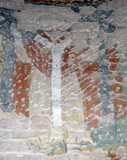


Fresco (12th century)
Apse, San Gregorio Maggiore
St Gregory first appears under 24th December in the Martyrology of Adon (858).
An entry in the Roman Martyrology under 24th December reads:
-
“At Spoleto, St. Gregory, priest and martyr. In the time of Emperors Diocletian and Maximian, he was first beaten with rough clubs, exposed on the gridiron and imprisoned, struck on the knees with iron carding instruments, burned on the sides with firebrands, and finally beheaded”.
A copy of the legend of St Gregory (BHL 3677 and 3677b) is preserved in the Leggandari del Duomo.
According to the legend, St Gregory was a priest who was martyred in the amphitheatre (see Walk II) in 303 AD during the reign of the Emperor Diocletian. His remains were to be fed to the wild animals, but St Abbondanza (the widow) bought them for a considerable sum of money. She buried them by “rivum qui Sanguinarius appellatur iuxta muros civitatis” (the river called Sanguinarius, near the city wall). This is almost certainly a reference to the Christian cemetery near Ponte Sanguinario (see Walk II). (For the historical background, see the page on Early Christianity in Spoleto).
Three churches in Spoleto are or were dedicated to St Gregory:
-
✴San Gregorio della Sinagoga, on the site on which he was imprisoned;
-
✴San Gregorio Minore, on the site of the Roman amphitheatre in which he was martyred; and
-
✴San Gregorio Maggiore, which St Abbondanza (the virgin) built near his grave in ca. 840 to house his relics. (An inscription records that this church was consecrated in 1146 as "Sanctorum Martirum Gregorii et Paractalis" (SS Gregory and Baractalis).
There are at least three documented cases of the early dispersal of relics of St Gregory from Spoleto in the 10th century:
-
✴In 951, Bruno of Cologne, the brother of the future Emperor Otto I, took some of them to Cologne. A bust reliquary (16th century) survives in the treasury of Cologne Cathedral.
-
✴In 970, a representative of Bishop Theoderic (Dietrich) I of Metz took what he believed to be the relics of St Gregory (although he found them in San Sabino) to Metz. Bishop Wigfrid of Verdun acquired these from the Emperor Otto I and translated them to the Abbey of St Paul de Verdun, which he founded in 970-3. St Gregory was one of the most important saints venerated at St Paul.
-
✴Bishop Olderico of Cremona (973-1004) took some of the them to Cremona.
Relics that were believed to be those of St Gregory of Spoleto were apparently discovered in San Gregorio Maggiore in 1388.
The Abbey of Saint Paul de Verdun was destroyed in 1552 and Cardinal Giovanni Evangelista Pallotta acquired the cranium of St Gregory when he was in Verdun in 1617. He kept a fragment for his new church of San Gregorio in his native Caldarola (near Camerino), which seem s to have been built on the site of a Lombard church of San Gregorio della Vigna.
Cardinal Pallotta gave the rest of the cranium to Decio Gelosi, the Prior of San Gregorio Maggiore in 1619.
-
✴Two reliquary busts associated with this relic are preserved in the sacristy of San Gregorio Maggiore:
-
•a gilded wooden reliquary bust (17th century), which has an inscription that records the donation of the cranium by Cardinal Pallotta to Prior Decio Gelosi; and
-
•a reliquary bust (ca. 1755), which is attributed to Francesco Giardoni, into which Bishop Paolo Bonavisa transferred this relic in 1755.
-
✴The reliquary from Saint Paul de Verdun found its way into the possession of Bishop Giovanni De Rossi of Ossero in Croatia and he translated it to the Duomo of Lussingrande in 1663. The Duomo there is now dedicated to St Gregory.
-
✴Bishop Carlo Giacinto Lascaris gave part of the cranium to the Grand Duke Cosimo III de' Medici in 1720.

